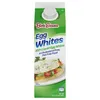Grocery Guides
Brown Eggs vs. White Eggs: How Are They Different?

Eggs are an essential ingredient in many sweet and savory recipes. The possibilities are endless when it comes to using these protein-packed powerhouses — you can scramble, fry, boil or poach eggs, or you can add them to your favorite dishes like ramen or avocado toast.
But how are you going to decide between brown eggs vs. white eggs?
Don’t worry if you’re unsure whether or not brown eggs are better than white eggs or if brown eggs taste different — we’ll answer all your egg-cellent questions below, and we even included a few recipe ideas to get you started.
What is the difference between white and brown eggs?

From the outside, white and brown eggs look different, but the color of the eggshell has no effect on the nutritional value or taste. The main difference between brown eggs vs. white eggs is the chicken breed. Typically, brown eggs are laid by larger chickens with red earlobes, while white eggs are laid by smaller chickens with white features.
Brown eggs are often laid by Rhode Island Reds, Plymouth Rocks and Orpingtons — these chicken breeds are larger than others and require more food. White eggs are produced by chickens with white features, like Leghorn chickens, which tend to be smaller.
Do eggs with different shell colors have a different taste?
While it may seem like brown eggs would have a different taste than white eggs, in reality, the eggshell color doesn’t affect the flavors.
The flavor of eggs varies depending on what the hens are eating. For example, fresh eggs from a local farmer may have a deeper-colored yolk, resulting in a more intense flavor than standard eggs from the supermarket. Overall, most eggs will taste the same, regardless of the shell color or how you cook your eggs.
Are brown eggs more expensive than white eggs?
As you peruse the grocery store or browse your grocery delivery service, you may notice the prices vary when looking at brown eggs vs. white eggs. The higher price tag doesn’t accompany the shell color but is instead associated with how the chickens are raised and how they produce the eggs.
Brown eggs are typically more expensive than white eggs simply because it costs more to feed the larger hens that produce this color of eggs — these chickens are significantly larger than those that produce white-colored eggs. The overall cost to feed these chickens and the level of care they need is factored into the consumer’s price.
What do the different egg labels mean?

With many varieties of food labels, it’s no surprise that you may feel confused. Regardless of whether you’re making breakfast sandwiches or baking something sweet, you should know what ingredients you’re using. Let’s take a closer look at some of the different types of eggs available and what these labels actually mean.
Organic
Eggs with an “organic” label come from chickens raised according to specific organic standards. These guidelines include feeding the chickens organic feed free from pesticides, herbicides and genetically modified organisms (GMOs). Organic eggs may also come from chickens that have outdoor access and aren’t treated with any antibiotics or hormones.
Free-range
Eggs labeled “free-range” means the hens have direct access to outside where they can roam, forage and partake in natural activities. Free-range chickens have access to outside areas during the day and return to their coop at night.
Pasture-raised
Similar to free-range eggs, eggs labeled “pasture-raised” means the chickens have some access to outside. However, pasture-raised chickens spend most of their time outside, grazing in grassy areas.
Cage-free
Just as it sounds, cage-free eggs come from chickens that aren’t kept in a cage. These hens have the freedom to roam freely within the barn or indoor area, but they don’t necessarily have direct access to the outdoors. The cage-free system provides more space for the hens to thrive compared to standard cages but not as much freedom as free-range or pasture-raised chickens.
Backyard or local
Eggs labeled “backyard” or “local” come from smaller producers and farmers in the local area. These eggs aren’t as common since they’re produced in smaller quantities and are often sold at farmers markets and local stores. This type of egg label doesn’t have any specific certifications like “organic” or “free-range,” but they are valued for their freshness, and many folks enjoy supporting local businesses — they also are a great way to make box cake taste better!
Omega-3-enriched
If you see an egg label that reads “omega-3-enriched,” it means the chickens are supplemented with omega-3 fatty acids like fish oil or flaxseed. Eggs that contain omega-3 are marketed as a health-conscious option for people looking to increase their fatty acid intake.
Grab it now on Instacart:
Egg recipe ideas
Not sure how to use the different types of eggs? Here are a few egg recipe ideas to get inspired.
- Quick egg salad
- Creamy deviled eggs
- Sausage and egg breakfast casserole
- Comforting egg drop soup
- Sous vide egg bites
- Savory egg casserole
- Perfect hard-boiled egg
- Savory egg fried rice
- Festive eggnog
- Perfect egg wash
- Smoked trout and spinach scrambled eggs
- Savory oatmeal with poached eggs
- Ranchero eggs over polenta
- Poached eggs caprese
Putting all your eggs in one basket
Now that you’re more familiar with brown eggs vs. white eggs, you’re ready to get cracking. Remember what organic, pasture-raised, cage-free, free-range and omega-3-enriched eggs mean. Keep in mind that the taste of the eggs will be fairly similar regardless of whether they’re white or brown eggs.
Shop all types (and colors) of eggs with the Instacart website and mobile app. Place an online order today and receive your groceries right to your door.
Looking to enhance your upcoming potluck? Try one of these breakfast potluck ideas to impress your friends and family.
Most Recent in Grocery Guides

Grocery Guides
15 Tasty Ice Cream Alternatives: Yogurt, Shaved Ice & More
Ice cream has been a beloved treat for generations. With its rich flavors and smooth texture, it’s no wonder people choose ice cream when looking for dessert. However, as dietary restrictions and health consciousness evolve,…...
Apr 10, 2024![When Is Artichoke Season? [Recipes + Guide]](https://www.instacart.com/company/wp-content/uploads/2024/03/when-is-artichoke-season-hero-447x224.webp)
Grocery Guides
When Is Artichoke Season? [Recipes + Guide]
Quick Answer When is artichoke season? In North America, artichoke season is from March to May, with smaller batches in October. Artichokes are a unique and versatile vegetable known for its tender heart and delicate…...
Mar 6, 2024
Grocery Guides
7 Best Oils for Frying and How To Use Them
Creating mouthwatering fried dishes boils down to the oil you use. Certain types of cooking oil not only cook your food to perfection but also enhance the flavors. Whether you’re whipping up chicken wings on…...
Feb 14, 2024











 Squash – All You Need to Know | Instacart Guide to Fresh Produce
Squash – All You Need to Know | Instacart Guide to Fresh Produce  Ghost Pepper – All You Need to Know | Instacart Guide to Fresh Produce
Ghost Pepper – All You Need to Know | Instacart Guide to Fresh Produce  Sprouts – All You Need to Know | Instacart Guide to Fresh Produce
Sprouts – All You Need to Know | Instacart Guide to Fresh Produce 

